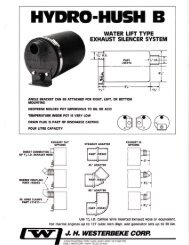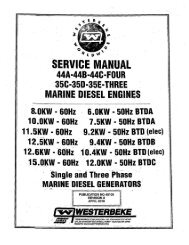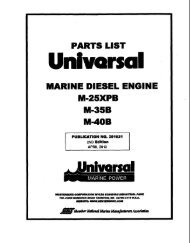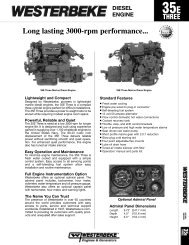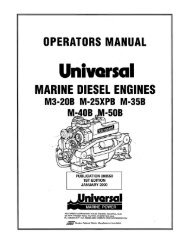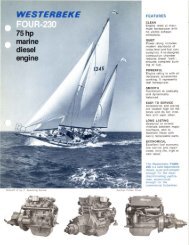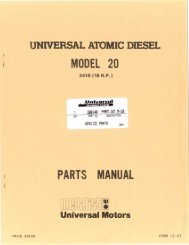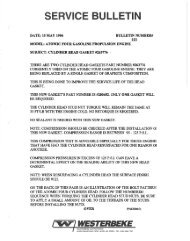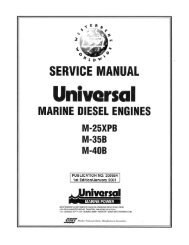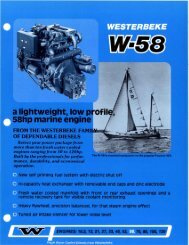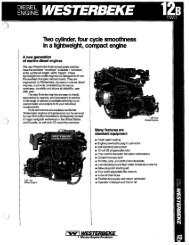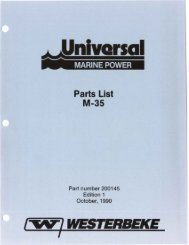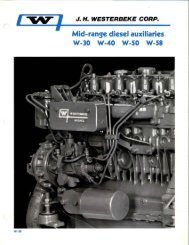OPERATORS MANUAL - Westerbeke
OPERATORS MANUAL - Westerbeke
OPERATORS MANUAL - Westerbeke
You also want an ePaper? Increase the reach of your titles
YUMPU automatically turns print PDFs into web optimized ePapers that Google loves.
DESCRIPTION<br />
Although your engine has experienced a minimum of one<br />
hour of tcst operations at the factory to make sure accurate<br />
assembly procedures were followed and that the engine operated<br />
properly, a break-in time is required. The service life of<br />
your engine is dependent upon how the engine is operated<br />
and serviced during its initial hours of use.<br />
Breaking-in a new engine basically involves seating the piston<br />
fings to the cylinder walls. Excessive oil consumption<br />
and smoky operation indicate that the cylinder walls arc<br />
scored, which is caused by overloading the generator during<br />
the break-in period.<br />
Your new engine requires approximately 50 hours of initial<br />
conditioning operation to break in each moving part in order<br />
to maximize the performance and service life of the engine.<br />
Perform this conditioning carefully, keeping in mind the<br />
following:<br />
Start the engine according to the STARTING PROCEDURE<br />
section. Run the engine while checking that all systems (raw<br />
water pump, oil pressure, battery charging) are functioning.<br />
AFTER START-UP<br />
Once the generator has been started, check for proper operation<br />
and then encourage a fast warm-up. Run the generator<br />
hetween 20% and 60% of full-load for the first 10 hours.<br />
A CAUTION: Do not attempt to break-in your<br />
generator by running without a load.<br />
After the first 10 hours of the generator's operatIOn, the load<br />
can be increased to the full-load rated output, then periodically<br />
vary the load.<br />
Avoid overload at all times. An overload is signaled by<br />
smoky exhaust with reduced output voltage and frequency.<br />
Monitor the current being drawn from the generator and keep<br />
it within the generator's rating. Since the generator operates<br />
at 1800 rpm to produce 60 hertz (or at 1500 rpm to produce<br />
50 Hertz), control of the generator's break-in is governed by<br />
the current drawn from the generator.<br />
GENERATOR BREAK-IN PROCEDURE<br />
...v WESTERBEKE<br />
Engines & Generators<br />
9<br />
CHECK THE FOLLOWING<br />
D Monitor the control panel gauges.<br />
o Check for leaks of fuel and engine oil.<br />
D Check for abnormal noise such as knocking, friction,<br />
vibration and blow-back sounds.<br />
D Confirm exhaust smoke:<br />
When the engine is cold - White Smoke.<br />
When the engine is warm - almost Smokeless.<br />
When the engine is overloaded - some Black Smoke.<br />
To protect against unintentional overloading of the generator,<br />
the generator's output leads should be routed through a circuit<br />
breaker that is rated at the rated output of the generator.<br />
NOTE: Be aware of motor starting loads and the high currelll<br />
draw required for Slarling motors. This starting amperage<br />
draw can be 3 to 5 limes normal running amperage. See<br />
GENERATOR INFORMATION ill [his manual.<br />
GENERATOR ADJUSTMENTS<br />
Once the generator has been placed in operation, there may<br />
be adjustments required for engine speed (hertz) during the<br />
engine's break-in period (first 50 hours) or after this period.<br />
A no-load voltage adjustment may also be required in conjunction<br />
with the engine's speed adjustment. See<br />
GENERATOR INFORMATION in this manual.



